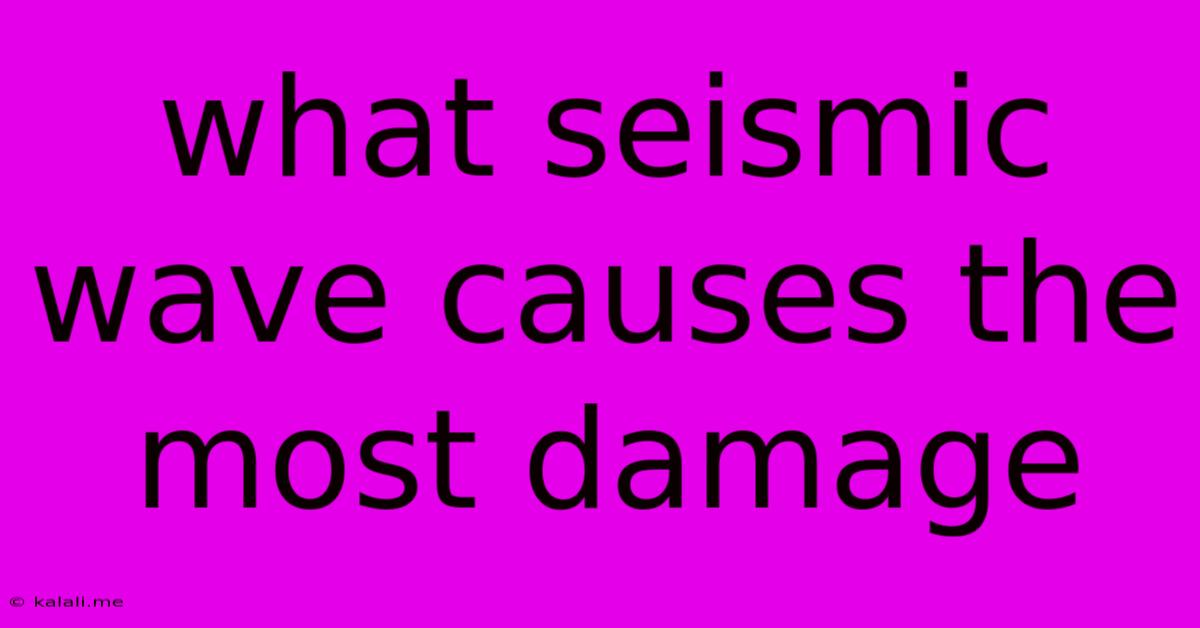What Seismic Wave Causes The Most Damage
Kalali
Jun 13, 2025 · 3 min read

Table of Contents
What Seismic Wave Causes the Most Damage? Understanding Earthquake Destruction
Earthquakes, terrifying displays of nature's power, unleash a cascade of seismic waves that wreak havoc across landscapes. But which of these waves is the primary culprit behind the widespread destruction we associate with these events? This article delves into the different types of seismic waves and explains why surface waves are generally responsible for the most damage during an earthquake.
Understanding the different types of seismic waves is crucial to comprehending the extent of earthquake damage. Seismic waves are essentially vibrations that travel through the Earth's layers after an earthquake. These waves are categorized into two main groups: body waves and surface waves.
Body Waves: The Underground Travelers
Body waves travel through the Earth's interior. There are two types of body waves:
-
P-waves (Primary waves): These are compressional waves, meaning they cause particles in the rock to move back and forth in the same direction as the wave is traveling. Think of it like a slinky being pushed and pulled. P-waves are the fastest seismic waves and are the first to arrive at a seismograph after an earthquake. While they can cause some shaking, their impact is generally less destructive than other wave types.
-
S-waves (Secondary waves): These are shear waves, causing particles to move perpendicular to the direction of wave propagation. Imagine shaking a rope up and down; the wave travels along the rope, but the rope itself moves up and down. S-waves are slower than P-waves and arrive second. They are more destructive than P-waves, causing significant ground shaking, but still less damaging than surface waves.
Surface Waves: The Destructive Duo
Surface waves travel along the Earth's surface and are responsible for the most significant damage during an earthquake. There are two primary types:
-
Rayleigh waves: These waves cause particles on the Earth's surface to move in an elliptical, rolling motion, similar to ocean waves. This rolling motion can be incredibly destructive, toppling structures and causing ground deformation. They are relatively slower than body waves.
-
Love waves: These waves are shear waves that travel along the Earth's surface, causing particles to move back and forth horizontally. This horizontal movement is particularly effective at causing significant ground shaking and structural damage. They are slower than Rayleigh waves but faster than S-waves.
Why Surface Waves Cause the Most Damage
Several factors contribute to the superior destructive power of surface waves:
-
Higher Amplitude: Surface waves generally have a much larger amplitude (the height of the wave) than body waves. This greater amplitude translates directly into more intense ground shaking.
-
Longer Duration: Surface waves travel along the surface, extending the duration of ground shaking. This prolonged shaking can cause cumulative damage to structures, exceeding the capacity of many buildings to withstand the forces.
-
Complex Ground Motion: The combination of Rayleigh and Love waves creates complex ground motion, making it difficult for structures to remain stable. The rolling and horizontal movements work together to amplify the destructive forces.
-
Concentration of Energy: Surface waves concentrate seismic energy near the Earth's surface, maximizing their impact on structures and infrastructure.
In conclusion, while both P-waves and S-waves contribute to the overall shaking during an earthquake, surface waves (Rayleigh and Love waves), with their larger amplitude, longer duration, and complex ground motion, are primarily responsible for the widespread damage observed after major seismic events. Understanding the characteristics of these different waves is crucial for earthquake preparedness, building codes, and mitigation strategies.
Latest Posts
Latest Posts
-
When Dissolved In Water All Acids Will
Jun 13, 2025
-
Shortcut Key To Increase Font Size
Jun 13, 2025
-
Lcm Of 2 5 And 7
Jun 13, 2025
-
The Main Difference Between Pert And Cpm Is That
Jun 13, 2025
-
Which Of The Following Statements Is True About Operant Conditioning
Jun 13, 2025
Related Post
Thank you for visiting our website which covers about What Seismic Wave Causes The Most Damage . We hope the information provided has been useful to you. Feel free to contact us if you have any questions or need further assistance. See you next time and don't miss to bookmark.